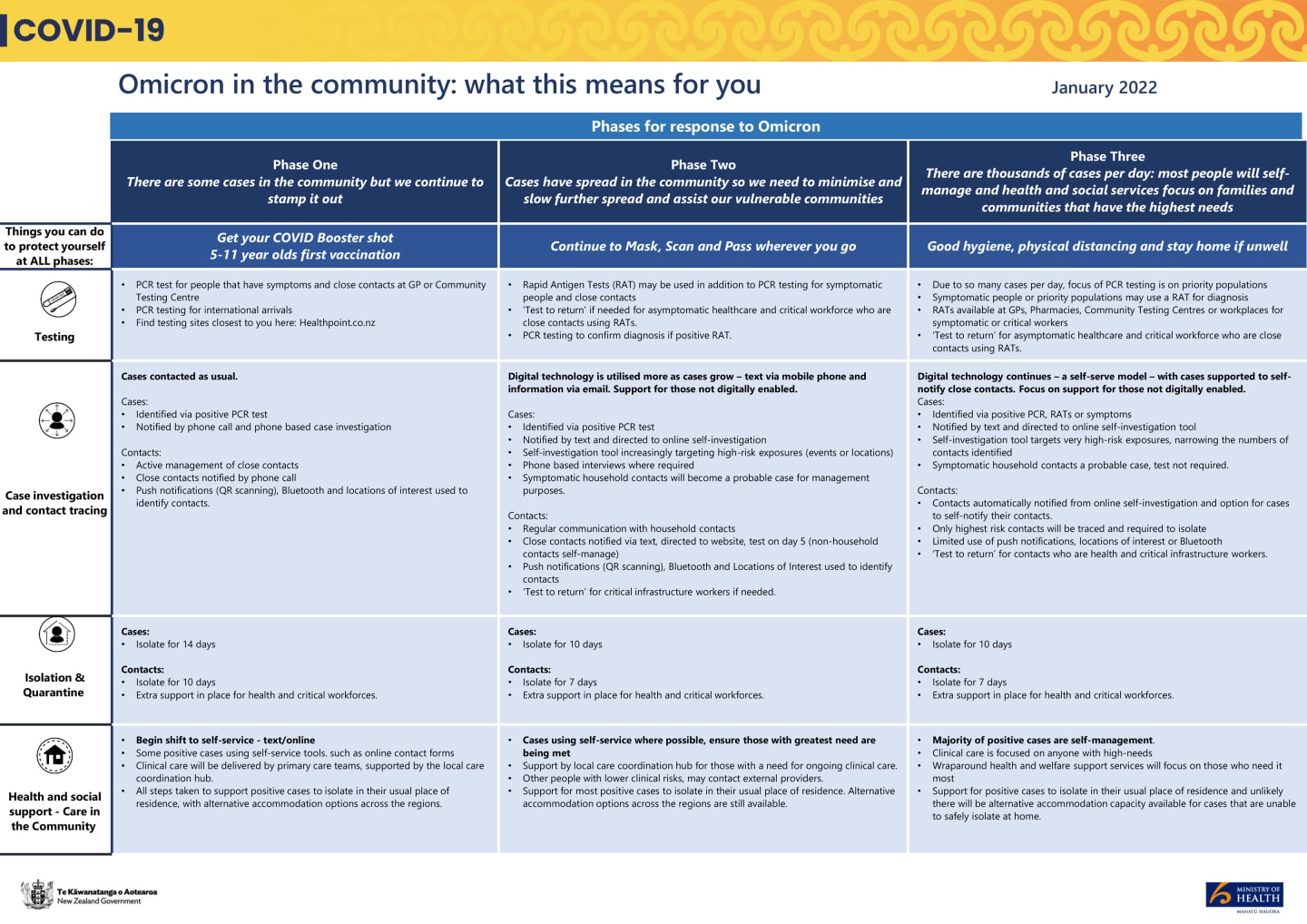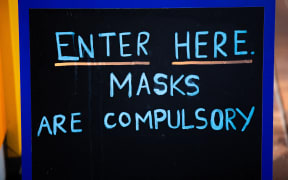Isolation periods for Covid-19 cases and close contacts will be reduced as the country goes through a new three-step approach to Omicron unveiled by the government this afternoon.
Associate Health Minister Ayesha Verrall has provided more detail on the government's new three-step approach to Omicron.
Watch the announcement here:
The first phase includes an intensive approach to contact tracing. Under the second phase, the focus will shift to people who are more at risk, and critical workers.
"This is ultimately about ensuring the wellbeing of all New Zealanders. This has been the principle of our Covid-19 response right from the beginning."
Dr Verrall said the number of cases will determine what phase the country is at. The country could move to Phase Two when numbers are less than 1000 a day, and to Phase Three prior to getting to tens of thousands a day.
Dr Verrall says New Zealanders step up when there's a job to do, and our high vaccination rates, the hard work the public health team and the traffic light system meant New Zealand could do what many countries around the world could not.
"We reduced the spread of Delta, emptied our ICU of Covid cases, and we're now in a good position to manage the spread of Omicron."
She said Omicron is the most transmissible variant and will spread fast, putting our health system and infrastructure under considerable pressure. She said new reports suggest Omicron cases double every two to four days, which meant a 10-case outbreak could mean more than 1000 cases per day within six to 12 days.
"It's important to remember that Covid-19 is markedly different to what it was in the beginning of the pandemic."
The new three-phase public health response to Omicron will include reducing the isolation period for cases and close contacts at Phase Two and Three to 10 and seven days.
There will also be increased use of rapid antigen tests and automated contact identification.

Photo: Ministry of Health
Phase One
New Zealand is currently in the first phase, said Dr Verrall.
"Broadly speaking, that includes the same contact tracing, isolation, and request that everyone who is symptomatic be tested at a community testing station or at a primary health provider.
"Our objective is to keep cases as low as possible for as long as possible to allow people to be boosted and children to be vaccinated without Omicron being widespread."
Phase Two
Phase Two will be designed to slow the spread and protect the country's vulnerable communities.
"The system will be adjusted to focus much more on identifying those who are at greater risk of severe illness from Omicron - which will be a smaller percentage of cases.
The isolation period in this phase will be 10 days for cases and seven days for contacts.
"Household contacts will actively be managed by contact tracing services, with close contacts requiring a PCR test on day five."
Dr Verrall said there would be an increased use of digital technology in this phase.
"Cases will be notified via text message and be directed to an online self-investigation tool which will focus on high risk exposures. Information will be provided via email and phone based interviews will still take place where it's required."
She said rapid antigen tests (RATs) will be integrated into the country's testing system at this phase and will work alongside PCR tests.
"They will be useful when the laboratories cannot provide PCR results within a useful time frame because of large volumes or because of transport delays."
Non-symptomatic critical workers will be allowed to return to work even if they are close contacts with a case. They will undergo daily symptom checks and daily rapid antigen tests prior to commencing work. They will strictly be required to use medical masks at work, changing their mask as needed throughout the day.
When removing the mask, for example for eating and drinking, they must maintain distancing - doing so alone and/or in a well ventilated space. They should travel to and from work or between jobs alone.
"Testing remains a cornerstone of our response," she said. Rapid antigen tests will become the go-to testing tool.
"The use of rapid antigen tests will enable PCR testing to be protected for use in key workforces such as healthcare, for surveillance at the border, and as diagnostic process in hospitals and acute care settings.
"We currently have good stock numbers of rapid antigen tests, and will release more details on the application, distribution, supply and funding for them in the next few weeks."
She said critical infrastructure providers will be able to order RATs for critical workers from the Ministry of Health as and when they need it.

Photo: RNZ / Angus Dreaver
Phase Three
In Phase Three, when cases are in the thousands, there will be further changes to contact tracing.
"The definition of contacts will change to household and household like contacts only. This will mean the highest risk contacts will need to isolate.
"Supported self-service, rapid antigen testing for diagnosing Covid and a self-service tool to enable identification of high risk contacts will be significant to respond to the high volumes of Omicron cases."
At Phase Three cases will be encouraged to self-notify close contacts, most cases would self-isolate at home, and clinical care and welfare support would be targeted based on need.
No guarantee NZ will reach Phase Three
The new announcements came after the government set out new rules for mask use and gave an update on the testing strategy yesterday.
The plans have already attracted criticism, with opposition parties accusing the government of taking rapid antigen tests (RATs) from the private sector and treating the public like children.
But Dr Verrall said the plan was designed to avoid the health system being overwhelmed.
"The numbers are part of it, and the numbers are likely to be less than 1000 a day before moving between phase one and phase two. And in terms of between phase two and phase three it could be in the thousands but not the tens of thousands."
She said Omicron is "uniquely transmissible" but it is less severe, so there may be a smaller proportion of people who will need to go to hospital, but there may well be many more people getting the virus who may be at risk of needing to go to hospital, which would put pressure on the system.
She said the plan was not based on modelling per se, and it is not guaranteed that New Zealand would go to phase three.
She said contact tracing is not a perfect system, and there would always be an element of risk, but the priority had to be safeguarding as many people as possible.






